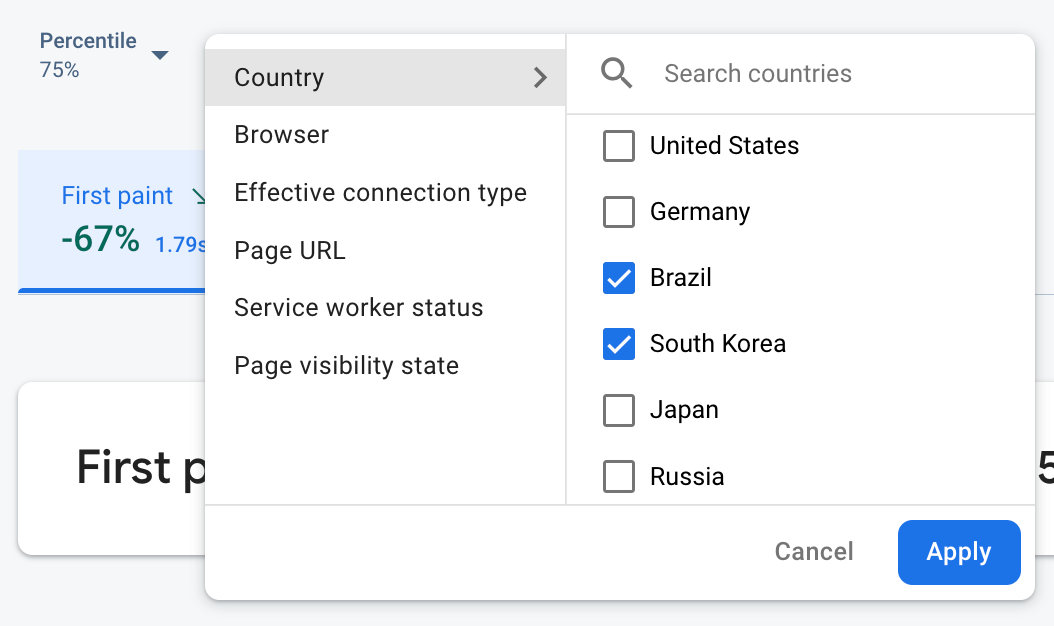Mit Performance Monitoring können Sie Leistungsdaten anhand von Attributen segmentieren und sich auf die Leistung Ihrer App in verschiedenen realen Szenarien konzentrieren.
Nachdem Sie in der Tabelle mit den Traces (unten im Leistungs-Dashboard) auf einen Tracenamen geklickt haben, können Sie die gewünschten Messwerte aufrufen. Mit der Schaltfläche
 Firebase Performance Monitoring-Daten werden nach Attribut gefiltert" />
Firebase Performance Monitoring-Daten werden nach Attribut gefiltert" />
- Filtern Sie nach Seiten-URL, um Daten für eine bestimmte Seite Ihrer Website aufzurufen.
- Filtern Sie nach Effektiver Verbindungstyp, um zu sehen, wie sich eine 3G-Verbindung auf Ihre App auswirkt.
- Filtern Sie nach Land, um sicherzustellen, dass sich der Standort Ihrer Datenbank nicht auf eine bestimmte Region auswirkt.
Standardattribute
Performance Monitoring erfasst automatisch eine Vielzahl von Standardattributen, je nach Art des Traces.
Zusätzlich zu diesen Standardattributen können Sie auch benutzerdefinierte Attribute für Ihre benutzerdefinierten Code-Traces erstellen, um Daten nach Kategorien zu segmentieren, die für Ihre App spezifisch sind. In einem Spiel können Sie Daten beispielsweise nach Spiellevel segmentieren.
Standardattribute, die für Web-Apps erhoben werden
Für alle Webanwendungen werden standardmäßig die folgenden Attribute erfasst:
- Browser
- Land
- Effektiver Verbindungstyp
- Seiten-URL
- Service Worker-Status
- Sichtbarkeit
Nutzerdaten erheben
Benutzerdefinierte Attribute erstellen
Sie können benutzerdefinierte Attribute für alle instrumentierten benutzerdefinierten Code-Traces erstellen.
Verwenden Sie die Performance Monitoring Trace API, um benutzerdefinierten Code-Traces benutzerdefinierte Attribute hinzuzufügen.
Wenn Sie benutzerdefinierte Attribute verwenden möchten, müssen Sie Ihrer App Code hinzufügen, der das Attribut definiert und es einem bestimmten benutzerdefinierten Code-Trace zuordnet. Sie können das benutzerdefinierte Attribut jederzeit zwischen dem Start und dem Ende des Traces festlegen.
Wichtige Hinweise:
Namen für benutzerdefinierte Attribute müssen die folgenden Anforderungen erfüllen:
- Keine voran- oder nachgestellten Leerzeichen, kein vorangestellter Unterstrich (
_) - Keine Gruppenbereiche
- Maximale Länge: 32 Zeichen
- Zulässige Zeichen für den Namen sind
A-Z,a-zund_.
- Keine voran- oder nachgestellten Leerzeichen, kein vorangestellter Unterstrich (
Für jeden benutzerdefinierten Code-Trace können bis zu 5 benutzerdefinierte Attribute erfasst werden.
Achten Sie darauf, dass benutzerdefinierte Attribute keine Informationen enthalten, die eine Person gegenüber Google identifizieren.
Weitere Informationen zu dieser Richtlinie
Web
import { trace } from "firebase/performance"; const t = trace(perf, "test_trace"); t.putAttribute("experiment", "A"); // Update scenario t.putAttribute("experiment", "B"); // Reading scenario const experimentValue = t.getAttribute("experiment"); // Delete scenario t.removeAttribute("experiment"); // Read attributes const traceAttributes = t.getAttributes();
Web
const trace = perf.trace("test_trace"); trace.putAttribute("experiment", "A"); // Update scenario trace.putAttribute("experiment", "B"); // Reading scenario const experimentValue = trace.getAttribute("experiment"); // Delete scenario trace.removeAttribute("experiment"); // Read attributes const traceAttributes = trace.getAttributes();

